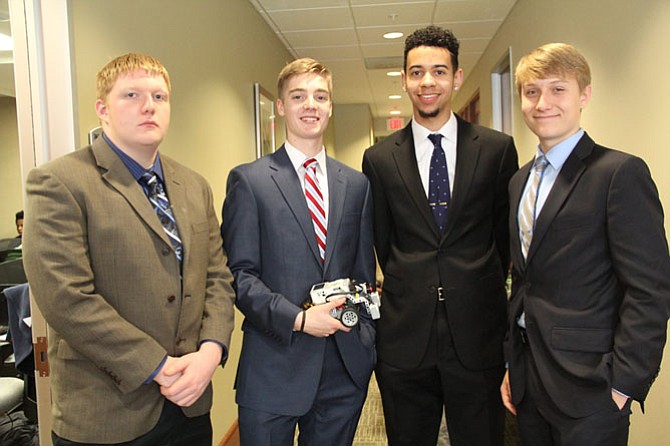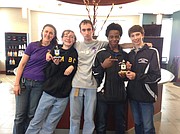Second place winners, TSA Robotics Team at Fairfax High School. From left: Alex Brenner, programmer; Taylor Serio, designer; Josh Williams, team leader; Eric Holsworth, team logistician. Photo courtesy of Tram Phung
In a competition that tested not only students’ robotics and engineering abilities, but also their public speaking and leadership skills, the Mini-Urban Challenge brought teams of high school students together to program and build miniature robots using LEGO Mindstorms EV3 kit to move, autonomously, through a 42-by-10-foot model city.
During the Washington, D.C. regional competition, held at the Basic Research Innovation and Collaboration Center (BRICC) in Arlington, students from area schools including Fairfax High School and Annandale High School, navigated their robots through a model city very reminiscent of Washington, D.C.
“The most challenging part is working with the sensors and having them read the colors,” said Alex Brenner, senior at Fairfax High School and programmer on his school’s team. “We probably worked on the robot for about a week, and programming since the beginning of school.”
In the competition, students are allowed to choose any programming language they want to program their robot, but their creation must then be able to successfully navigate through a map of an urban environment.
COLORED STRIPS on the map’s course provided instructions to the robots as they navigated the course, and students were scored based on how well their robot could move through the course map, and on how they presented their robot to a panel of judges. Seventy percent of the overall score was based on robotic engineering, and 30 percent was based on presentation.
“Students work in teams,” said Fairfax High School coach, Emre Ege. “It involves programming and planning…[There are] lots of educational benefits not available in schools.” In 2014, Fairfax High School came in first place, nationally, in the Mini-Urban Challenge. But more important than winning is the chance for students to gain exposure to STEM careers, and to possibly use computer science in the future. In a lighthearted, yet competitive environment where the students got to work with Legos, sometimes it was not all fun and games.
“It’s been a bit stressful,” said Andrew Abdow, Centennial High School team captain during the Mini-Urban Challenge.
“We could have done a lot better,” said Antares Chen, team captain for Montgomery Blair High School. “We’re hoping in the second part we’ll have our code debugged.” Students competed twice, in the morning and afternoon of the competition.
At the end of the day, the Banana Seals from Long Reach High School in Columbia, Md. were awarded first place and also named “Best in Show,” and TSA Robotics from Fairfax High School came in second place. For their wins, teams from both high schools will also be able to attend the ST Global Conference, an annual conference on “Science and Technology in Society” held in Washington, D.C. There, they will have a chance to present their robotics designs as practice for the national competition.
THE MINI-URBAN CHALLENGE is made possible by the Doolittle Institute, a Florida non-profit that connects the Air Force Research Laboratory Munitions Directorate with the academic community, small businesses, and other organizations linked to the sciences, technology and research. The Institute’s goal is to make this competition available to as many students as possible.
“It is a no-cost competition,” said Beth Hanning, Director of STEM Education Outreach for the Doolittle Institute. Teams competing for the first time receive their EV3 Mindstorms robotic kit, for free, from the Doolittle Institute. “This allows economically challenged teams to compete when they ordinarily would not have the opportunity,” said Hanning.
“The goal is to increase interest in STEM careers,” said Henry Parrott, an intern at BRICC, “We do this to help with general talent outreach.
The national competition will take place at the Tampa Civic Center on May 15-16, where students from Fairfax High School will be competing.
To keep up with the Mini-Urban Challenge competition, visit http://miniurbanchallenge.com/.



